Whether you’re a seasoned gardener sculpting your green canvas or a homeowner seeking to tame an overgrown backyard, a whipper snipper, string trimmer or line trimmer, is an indispensable tool in your gardening arsenal. Its precision and versatility make it ideal for giving your lawn that perfect edge or clearing out areas where mowers dare not tread. But with a plethora of options available, choosing the right whipper snipper can be as complex as the landscapes it shapes.
In this essential guide, we delve into the world of whipper snippers, offering comprehensive insights to aid you in selecting the most suitable model for your needs, using it with masterful efficiency, and maintaining it for years of reliable service. We’ll explore the various types available, dissect the features you should look out for, and share expert advice on getting the best performance out of your chosen device. From eco-friendly considerations to the latest in landscaping technology, we’ve got you covered.
As you navigate through this guide, you’ll find references to in-depth articles. These pieces are designed to enrich your understanding and provide detailed exploration into specific areas of interest. Together, they create a tapestry of information that will transform you from a casual user to a whipper snipper connoisseur.
So, strap on your safety gear and prepare to embark on a journey to unlock the full potential of your garden with the help of your trusty whipper snipper.
Understanding Whipper Snippers
Before diving into the selection and use of whipper snippers, it’s crucial to understand exactly what these tools are and the versatility they offer. A whipper snipper, also known as a string trimmer, line trimmer, or weed eater in various parts of the world, is a tool designed for trimming grass and small plants with a flexible monofilament line instead of a blade. The versatility and ease of use make whipper snippers a must-have for both professional landscapers and gardening enthusiasts.
Types of Whipper Snippers:
Whipper snippers come in several types, each with its own set of advantages and suitable use cases:
- Electric Whipper Snippers: These are typically lighter and quieter than their petrol counterparts and are ideal for smaller gardens or areas close to a power source. They’re available in both corded and cordless models, with the latter offering greater mobility at the expense of battery life.
- Petrol Whipper Snippers: Offering more power and mobility, petrol models are the go-to for larger areas and more demanding tasks. They can handle thicker weeds and longer grass and don’t restrict you with a battery life or cord. However, they require more maintenance and are louder and heavier.
- Battery-Powered Whipper Snippers: These are a subset of electric models and are gaining popularity due to their convenience and improvements in battery technology. They strike a balance between the mobility of petrol models and the quieter operation of electric ones.
Key Components of a Whipper Snipper:
Understanding the key components of a whipper snipper will help you operate it more effectively:
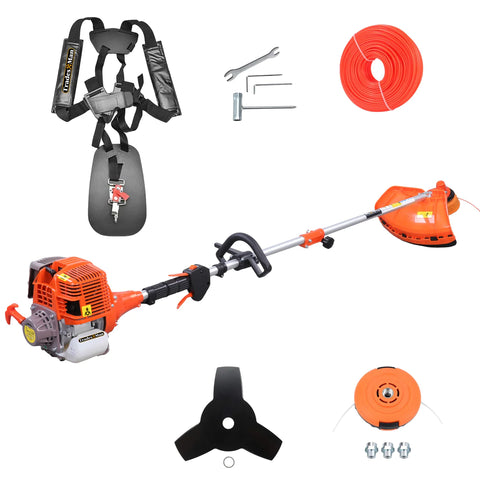
- Cutting Head: This is where the line is housed and spins at high speed to cut through vegetation. There are different head types, including single-line and dual-line models, and those with bump feed or automatic feed systems for the cutting line.
- Shaft: The shaft connects the cutting head to the motor and can be straight or curved. Straight shafts are typically better for reaching under obstacles, while curved shafts can be more ergonomic and comfortable to use.
- Motor: Positioned either at the top or bottom of the unit, the motor powers the cutting line. Its location can affect the balance and weight distribution of the tool.
- Handle: This is where you hold and control the whipper snipper. Handles can vary in shape and size, affecting user comfort and control.
- Safety Guard: A vital component that helps protect you from flying debris.
Environmental Considerations:
In our environmentally-conscious times, it’s important to consider the impact of your gardening tools. Electric and battery-powered whipper snippers typically have a smaller carbon footprint than petrol models. They are also quieter, which can be a significant factor if you live in a noise-sensitive area or wish to minimize disturbance to your neighbors.
As we progress through this guide, keep these types and components in mind. They will be the foundation upon which we build our understanding of how to select, use, and maintain these versatile tools to keep your garden in pristine condition.
Selecting the Right Whipper Snipper
The selection of a whipper snipper is as much about the tool's capabilities as it is about the user's needs. To ensure you choose a whipper snipper that not only tackles your garden's challenges but also aligns with your comfort and usage requirements, consider the following factors:
Garden Size and Terrain
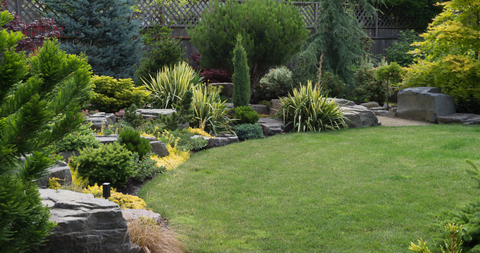
- For smaller gardens with minimal rough terrain, an electric whipper snipper might be the perfect fit due to its lightweight and ease of maneuverability.
- Larger gardens with uneven terrain demand a more robust solution, such as a petrol whipper snipper, which offers the power needed to cut through thick vegetation and the autonomy required for extensive use.
Power Source:
- Electric (Corded): Best for those who have easy access to a power outlet and a smaller area to maintain.
- Battery (Cordless): Ideal for medium-sized areas where the freedom of movement is key, and the noise and maintenance of petrol are a concern.
- Petrol: The choice for professionals and those with large, demanding spaces that require extended use and more power.
Weight and User Comfort:

- A whipper snipper that is too heavy can lead to user fatigue, reducing efficiency and enjoyment. Test the feel of the tool in-store if possible, or check the weight specification before purchasing.
- Ergonomic design is key. Look for adjustable handles and harnesses that distribute weight evenly to make the task more comfortable.
Ease of Use:
- Consider features like 'tap-and-go' line feeding, which allows you to extend the cutting line with a simple tap on the ground.
- Also, assess the ease of starting the device; modern petrol models have improved significantly, and battery-powered models offer the convenience of push-button starting.
Safety Features:
- Ensure the whipper snipper has a substantial safety guard to protect you from flying debris.
- Look for models with additional safety features like trigger locks and emergency stop buttons.
Maintenance Requirements:
- Electric and battery-powered models generally require less maintenance compared to petrol models, which need regular engine checks and fuel refills.
Environmental Impact:
- If environmental impact is a concern, consider the emissions of petrol models versus the electric alternatives. The latter provides a greener solution.
Budget:
- While budget considerations are important, investing in a higher-quality whipper snipper can save money in the long run due to lower maintenance costs and longer lifespan.
Selecting the right whipper snipper is about assessing your garden size and needs, balancing the power and capabilities of the tool with the specifics of your garden and personal preferences. With the right choice, garden maintenance becomes not just a chore, but a pleasure.
Whipper Snipper Features and Technology
With the right whipper snipper in hand, gardening can go from a weekend chore to an enjoyable and satisfying activity. Modern whipper snippers come packed with features and technology designed to enhance efficiency and comfort. Understanding these can help you make the best choice for your gardening needs.
Cutting Width:
- The cutting width of a whipper snipper determines how much ground you can cover with each pass. A larger cutting width is great for open areas, while a smaller width provides precision for tight spaces.
Line Feed System:
-
The line feed system is how the trimmer advances the cutting line. Options include:
- Bump Feed: Where you tap the head on the ground to release more line.
- Automatic Feed: Where the line advances automatically without the need for bumping.
- Manual Feed: Where you stop the machine and advance the line by hand.
Adjustable Heads and Shafts:
- Adjustable heads can pivot to various angles, making it easier to trim along edges and around obstacles.
- Telescopic shafts allow for length adjustment, catering to the user's height and the task at hand.
Power Adjustment:
- Some models come with variable power settings, which can be very useful when you need to conserve battery life or when tackling different types of vegetation.
Safety Features:
- Features such as quick stop buttons and shield guards provide added safety, which is especially important for beginners or when the whipper snipper is used in close proximity to other people or pets.
Noise Level and Vibration Reduction:
- Electric models tend to be quieter than petrol models, which is a critical factor in residential areas.
- Anti-vibration technology reduces fatigue and makes the whipper snipper more comfortable to use over extended periods.
Ease of Maintenance:
- Look for models that offer easy access to replaceable parts, straightforward cleaning, and minimal lubrication requirements.
Ergonomics:
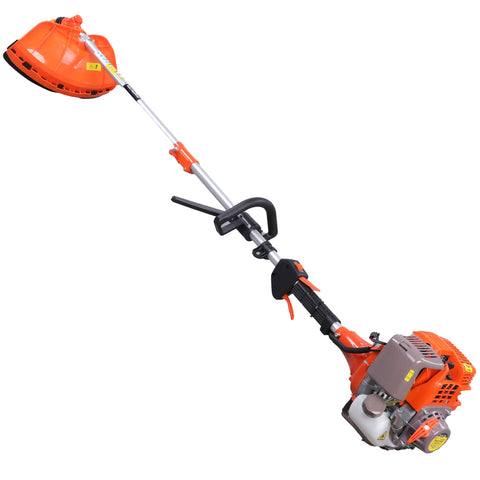
- Comfortable grips, balanced weight distribution, and harnesses can significantly reduce strain and improve maneuverability.
Attachments and Accessories:
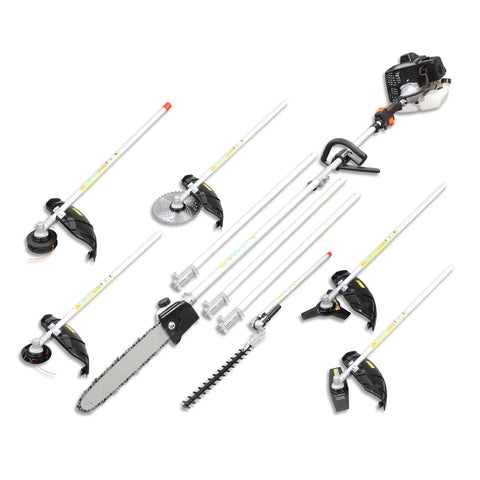
- Some whipper snippers come with the ability to attach different heads for tasks like edging, hedge trimming, or even turning the whipper snipper into a blower or cultivator.
By matching these features to the demands of your garden, you can ensure a well-groomed outdoor space with less effort and more satisfaction.
Remember, technology is there to make our lives easier, and the right features on your whipper snipper can transform it from a mere tool into a gardening ally.
Using Your Whipper Snipper Safely and Effectively
After selecting the perfect whipper snipper, it's essential to understand how to use it safely and efficiently. A whipper snipper can be a formidable tool when used correctly, but it requires respect for its cutting power and an awareness of safety protocols.
Safety Precautions:
- Protective Gear: Always wear the appropriate protective gear, including safety glasses, gloves, long pants, and sturdy boots. Hearing protection is also crucial, especially with petrol models.
- Read the Manual: Before you start, read the user manual thoroughly. Each model has specific operational guidelines and safety warnings.
- Inspect the Area: Clear the area of debris, toys, rocks, or anything that the trimmer line could hit and eject.
- Mind the Power Cord: If using an electric model, be constantly aware of where the power cord is to avoid cutting it.
Effective Use:
- Cutting Technique: Use a sweeping motion from side to side, cutting no more than one-third of the grass blade length at a time to avoid scalping the lawn.
- Edging: Many whipper snippers can be turned on their side to edge along sidewalks and driveways. Some models have special edging features or attachments for precision work.
- Avoiding Obstacles: Be cautious around trees and shrubs. The trimmer line can damage tree bark and plant stems, which can be harmful to the plant's health.
- Maintenance Breaks: Regularly stop to check for line wear and replace the line when needed, ensuring consistent cutting performance.
Efficiency Tips:
- Plan Your Path: Before you start, plan your trimming path. Work systematically to avoid going over the same area twice and to ensure all areas are covered.
- Battery Management: For cordless models, keep your work within the battery's run time, and have a spare charged battery ready if needed.
- Right Time to Trim: The best time to trim is when the grass is dry. Wet grass can clog the trimmer head and is harder to cut cleanly.
Maintenance and Care:
- Post-Use Cleaning: After each use, clean the trimmer head of grass and debris to maintain optimal performance.
- Storage: Store your whipper snipper in a clean, dry place out of the reach of children.
- Regular Checks: Periodically check for loose screws, worn parts, or damage, especially to the safety guard and line.
Using your whipper snipper effectively requires a combination of proper technique, routine maintenance, and an uncompromising commitment to safety. By following these guidelines, you'll ensure a well-maintained landscape and a safe experience every time you tackle your garden.
Enhancing Your Experience
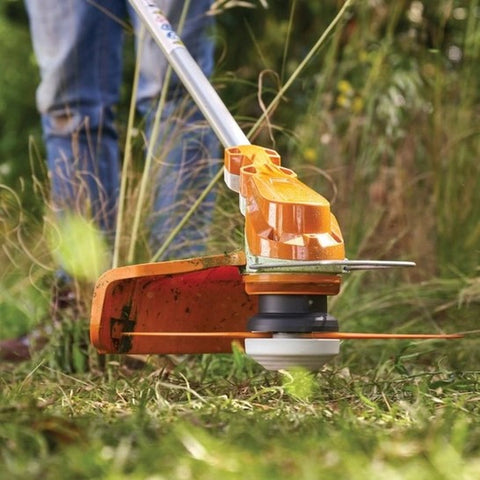
While whipper snippers are straightforward tools, there are numerous ways to enhance your experience and achieve even better results in your garden. Here are some tips and add-ons that can turn a standard trim into a landscaping triumph:
Choose the Right Trimmer Line:
- The thickness and shape of the trimmer line can impact cutting efficiency. Thicker, squared, or star-shaped lines can cut more effectively and are better for tougher vegetation.
Utilize Attachments:
- Many whipper snippers offer attachments that can turn your trimmer into a multi-tool, capable of edging, hedge trimming, or even tilling small garden beds.
Embrace Technology:
- Modern trimmers may come with apps or Bluetooth connectivity that can help track maintenance schedules, battery life, or even guide you on proper usage patterns.
Invest in Comfort:
- A good harness can distribute the weight of the trimmer, reducing fatigue. For models without a built-in harness, aftermarket options are available.
Learn Advanced Techniques:
- Techniques like "edging" for crisp lines along sidewalks, and "tapering" for a graded transition on the edges of lawns, can significantly improve the appearance of your yard.
Maintenance Kits:
- Some manufacturers offer maintenance kits with all the necessary tools and replacement parts for routine care, making it convenient to keep your trimmer in top condition.
Safety Upgrades:
- Consider additional safety upgrades like reinforced safety guards or cut-resistant trousers, especially if you're working in rough terrain.
By taking advantage of these enhancements, you can not only make the work easier and more enjoyable but also achieve a more professional finish to your garden, making it the envy of the neighborhood.
Environmental Impact and Sustainability
In today’s environmentally-conscious world, it’s important to consider the impact of our gardening tools on the ecosystem. Whipper snippers, like all garden equipment, have an environmental footprint that can be managed and minimized with thoughtful use and the right choices.
Eco-Friendly Models:
- Electric and battery-powered whipper snippers are generally more environmentally friendly than petrol models, as they produce zero emissions at the point of use and are quieter, reducing noise pollution.
Proper Disposal of Waste:
- Be mindful of how you dispose of yard waste after trimming. Composting or proper green waste disposal methods can prevent landfill buildup and reduce methane emissions.
Efficient Use of Resources:
- Using your whipper snipper efficiently can save energy. Plan your trimming to minimize time and electricity or fuel usage.
- Maintain your batteries properly and recycle them at the end of their life cycle to prevent harmful substances from entering the environment.
Biodegradable Trimmer Lines:
- Some manufacturers offer biodegradable trimmer lines, which break down faster than traditional lines if left in the environment, reducing plastic waste.
Low-Emission Petrol Models:
- If a petrol model is necessary for your needs, look for one that is certified as low-emission to help reduce the output of harmful pollutants.
Maintenance and Fuel:
- Proper maintenance can ensure that petrol models run more efficiently and cleanly. Additionally, consider using a cleaner-burning fuel or fuel additives that reduce emissions.
By making informed choices and using your whipper snipper responsibly, you can enjoy a well-maintained garden while also contributing to the well-being of the planet.
Expert Advice and Insider Tips
To truly master the art of using a whipper snipper, it helps to listen to those who have honed their skills over years of landscaping. Here are some expert insights and tips that can elevate your technique and ensure you get professional results every time.
Understand the Terrain:
- Survey your garden before you start. Knowing the layout of the land helps you plan your approach and avoid obstacles.
Right Equipment for the Job:
- Experts match the trimmer to the task. Use a light-duty trimmer for grass and a heavy-duty one for denser weeds and brush.
Perfect Your Technique:
- Develop a steady, sweeping motion. The tip of the line does the cutting, so keep the head slightly tilted towards the area being trimmed.
- Move against the rotation for a cleaner cut and to direct debris away from you.
Timely Trimming:
- The best time to trim is late afternoon. The grass is usually dry, and the cooler temperature reduces stress on both the plant and the trimmer.
Maintenance Routines:
- Create a maintenance schedule and stick to it. Regularly sharpen blades, change the line, clean filters, and check for wear and tear.
Battery Optimization:
- For battery-powered models, store batteries in a cool, dry place and avoid charging them immediately after use. Let them cool down first.
Learn from Mistakes:
- Even professionals make mistakes. Learn from them, and don’t be afraid to adjust your methods.
Stay Informed:
- Technology and best practices evolve. Stay up to date by reading industry publications, attending workshops, or watching tutorial videos.
Community Engagement:
- Share your experiences and learn from others. Gardening communities, both online and local, can be invaluable resources.
With the right knowledge and a bit of practice, you can use your whipper snipper to achieve a pristine, professionally-landscaped look in your own garden.
Throughout this guide, we've journeyed from understanding the basics of these versatile tools to selecting the right model, maintaining it, and employing professional techniques for optimal use. The whipper snipper, an unassuming yet powerful ally in garden care, when wielded with knowledge and care, can transform an unruly outdoor space into a manicured landscape. If you are interested in purchasing a high quality and powerful whipper snipper, specifically designed for the Australian market please consider exploring our own selection.
Remember, the key to success with your whipper snipper lies in:
- Choosing Wisely: Select a model that fits both your garden's needs and your own comfort.
- Maintaining Diligently: Keep up with regular maintenance to ensure longevity and peak performance.
- Using Safely and Efficiently: Employ the right techniques and safety measures for the best results.
- Staying Eco-Conscious: Make choices that minimize your environmental impact while maximizing garden health.
As you apply the insights from this guide, you'll not only become more proficient with your whipper snipper but also enjoy the process of creating and maintaining a beautiful garden.
We invite you to share your own experiences, tips, and questions in the comments below or on our social media channels. Your input enriches the conversation and helps us all grow as garden enthusiasts.
Happy trimming, and may your garden flourish!

